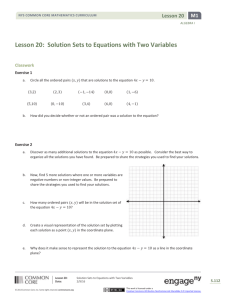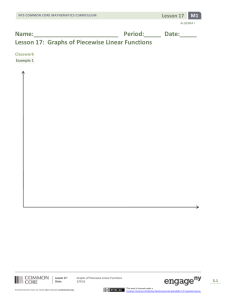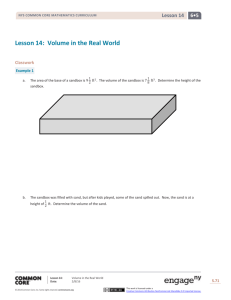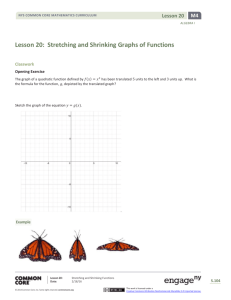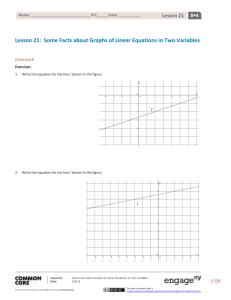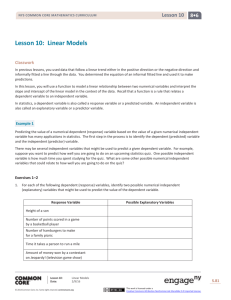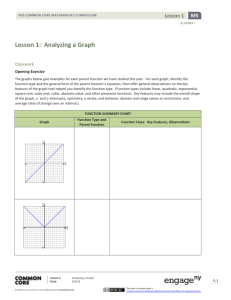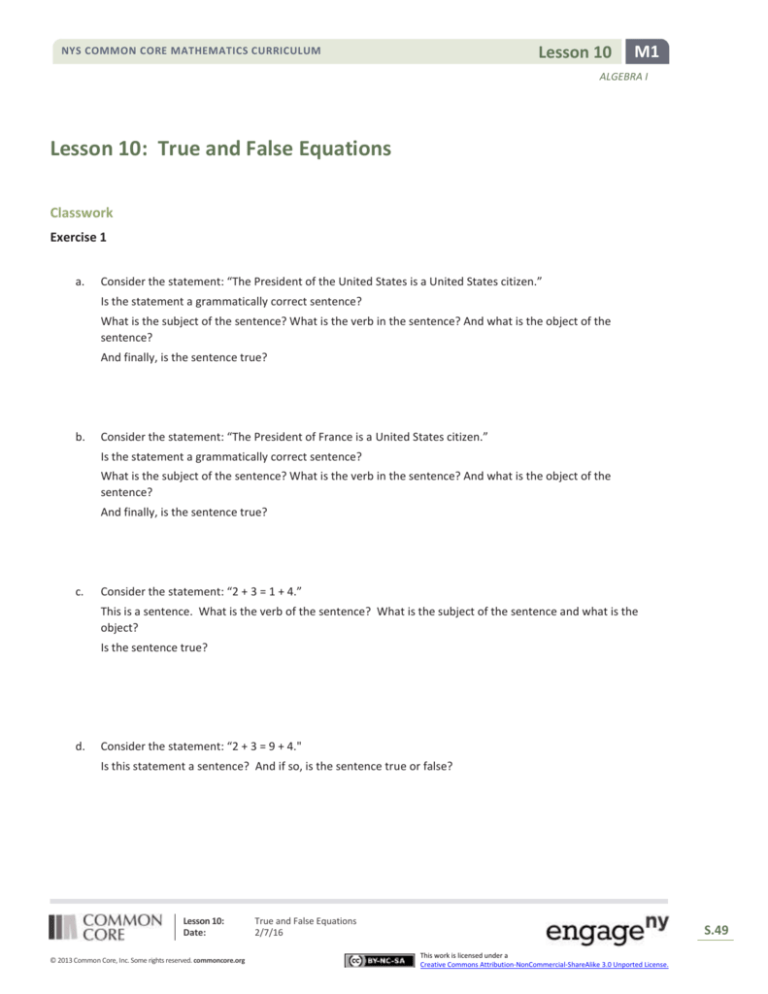
Lesson 10
NYS COMMON CORE MATHEMATICS CURRICULUM
M1
ALGEBRA I
Lesson 10: True and False Equations
Classwork
Exercise 1
a.
Consider the statement: “The President of the United States is a United States citizen.”
Is the statement a grammatically correct sentence?
What is the subject of the sentence? What is the verb in the sentence? And what is the object of the
sentence?
And finally, is the sentence true?
b.
Consider the statement: “The President of France is a United States citizen.”
Is the statement a grammatically correct sentence?
What is the subject of the sentence? What is the verb in the sentence? And what is the object of the
sentence?
And finally, is the sentence true?
c.
Consider the statement: “2 + 3 = 1 + 4.”
This is a sentence. What is the verb of the sentence? What is the subject of the sentence and what is the
object?
Is the sentence true?
d.
Consider the statement: “2 + 3 = 9 + 4."
Is this statement a sentence? And if so, is the sentence true or false?
Lesson 10:
Date:
© 2013 Common Core, Inc. Some rights reserved. commoncore.org
True and False Equations
2/7/16
S.49
This work is licensed under a
Creative Commons Attribution-NonCommercial-ShareAlike 3.0 Unported License.
49
Lesson 10
NYS COMMON CORE MATHEMATICS CURRICULUM
M1
ALGEBRA I
A number sentence is a statement of equality between two numerical expressions.
A number sentence is said to be true if both numerical expressions are equivalent (that is, both evaluate to the same
number). It is said to be false otherwise. True and false are called truth values.
Exercise 2
Determine whether the following number sentences are TRUE or FALSE.
e.
f.
4 + 8 = 10 + 5
1
5
+ 8 = 1.2 − 0.075
2
g.
(71 · 603) · 5876 = 603 · (5876 · 71)
h.
13 × 175 = 13 × 90 + 85 × 13
i.
(7 + 9)2 = 72 + 92
j.
𝜋 = 3.141
Lesson 10:
Date:
© 2013 Common Core, Inc. Some rights reserved. commoncore.org
True and False Equations
2/7/16
S.50
This work is licensed under a
Creative Commons Attribution-NonCommercial-ShareAlike 3.0 Unported License.
50
NYS COMMON CORE MATHEMATICS CURRICULUM
Lesson 10
M1
ALGEBRA I
k.
l.
m.
n.
√(4 + 9) = √4 + √9
1
2
1
2
1
2
1
2
3
5
1
2
3
6
1
5
3
6
+ =
+ =
+ =
o.
32 + 42 = 72
p.
32 × 42 = 122
q.
32 × 43 = 126
r.
32 × 33 = 35
Lesson 10:
Date:
© 2013 Common Core, Inc. Some rights reserved. commoncore.org
True and False Equations
2/7/16
S.51
This work is licensed under a
Creative Commons Attribution-NonCommercial-ShareAlike 3.0 Unported License.
51
Lesson 10
NYS COMMON CORE MATHEMATICS CURRICULUM
M1
ALGEBRA I
Exercise 3
a.
Could a number sentence be both TRUE and FALSE?
b.
Could a number sentence be neither TRUE nor FALSE?
An algebraic equation is a statement of equality between two expressions.
Algebraic equations can be number sentences (when both expressions are numerical), but often they contain
symbols whose values have not been determined.
Exercise 4
a.
Which of the following are algebraic equations?
i.
3.1𝑥 − 11.2 = 2.5𝑥 + 2.3
ii.
10𝜋 4 + 3 = 99𝜋 2
iii.
𝜋 + 𝜋 = 2𝜋
iv.
v.
b.
1
2
1
2
2
4
+ =
3
79𝜋 + 70𝜋 2 − 56𝜋 + 87 =
60𝜋+29,928
𝜋2
Which of them are also number sentences?
Lesson 10:
Date:
© 2013 Common Core, Inc. Some rights reserved. commoncore.org
True and False Equations
2/7/16
S.52
This work is licensed under a
Creative Commons Attribution-NonCommercial-ShareAlike 3.0 Unported License.
52
Lesson 10
NYS COMMON CORE MATHEMATICS CURRICULUM
M1
ALGEBRA I
c.
For each number sentence, state whether the number sentence is true or false.
Exercises 5
When algebraic equations contain a symbol whose value has not yet been determined, we use analysis to determine
whether:
1.
The equation is true for all the possible values of the variable(s), or
2.
The equation is true for a certain set of the possible value(s) of the variable(s), or
3.
The equation is never true for any of the possible values of the variable(s).
For each of the three cases, write an algebraic equation that would be correctly described by that case. Use only the
variable, 𝑥, where 𝑥 represents a real number.
Example 1
Consider the following scenario.
Julie is 300 feet away from her friend’s front porch and observes, “Someone is sitting on the porch.”
Given that she didn’t specify otherwise, we would assume that the “someone” Julie thinks she sees is a human. We
can’t guarantee that Julie’s observatory statement is true. It could be that Julie’s friend has something on the porch that
merely looks like a human from far away. Julie assumes she is correct and moves closer to see if she can figure out who
it is. As she nears the porch she declares, “Ah, it is our friend, John Berry.”
Lesson 10:
Date:
© 2013 Common Core, Inc. Some rights reserved. commoncore.org
True and False Equations
2/7/16
S.53
This work is licensed under a
Creative Commons Attribution-NonCommercial-ShareAlike 3.0 Unported License.
53
Lesson 10
NYS COMMON CORE MATHEMATICS CURRICULUM
M1
ALGEBRA I
Exercise 6
Name a value of the variable that would make each equation a true number sentence.
Here are several examples of how we can name the value of the variable:
Let 𝑤 = −2, then 𝑤 2 = 4 is true.
Or:
𝑤 2 = 4 is true when 𝑤 = −2
Or:
𝑤 2 = 4 is true if 𝑤 = −2
Or:
𝑤 2 = 4 is true for 𝑤 = −2 and 𝑤 = 2.
There might be more than one option for what numerical values to write. (And feel free to write more than one
possibility.)
Warning: Some of these are tricky. Keep your wits about you!
a.
Let
, then 7 + 𝑥 = 12 is true.
b.
Let
, then 3𝑟 + 0.5 =
c.
𝑚3 = −125 is true for
d.
A number 𝑥 and its square, 𝑥 2 have the same value when
e.
The average of 7 and 𝑛 is −8 if
f.
Let
g.
𝑞 + 67 = 𝑞 + 68 is true for
37
2
is true.
.
.
.
, then 2𝑎 = 𝑎 + 𝑎 is true.
Lesson 10:
Date:
© 2013 Common Core, Inc. Some rights reserved. commoncore.org
.
True and False Equations
2/7/16
S.54
This work is licensed under a
Creative Commons Attribution-NonCommercial-ShareAlike 3.0 Unported License.
54
Lesson 10
NYS COMMON CORE MATHEMATICS CURRICULUM
M1
ALGEBRA I
Problem Set
Determine whether the following number sentences are true or false.
50
2
1.
18 + 7 =
4.
52 + 122 = 132
2.
3.123 = 9.369 ∙
5.
(2𝑥2)2 = √256
1
(123 + 54) ∙ 4 = 123 + (54 ∙ 4)
3.
3
4
6.
3
= 1.333
In the following equations, let 𝑥 = −3 and 𝑦 = 2/3. Determine whether the following equations are true, false, or
neither true nor false.
7.
𝑥𝑦 = −2
8.
10. 9𝑦 = −2𝑥
𝑥 + 3𝑦 = −1
9.
11. 𝑦/𝑥 = −2
𝑥+𝑧 =4
12. (−2/𝑥)/𝑦 = −1
For each of the following, assign a value to the variable, 𝑥, to make the equation a true statement.
13. (𝑥 2 + 5)(3 + 𝑥 4 )(100𝑥 2 − 10)(100𝑥 2 + 10) = 0 for
14. √(𝑥 + 1)(𝑥 + 2) = √20 for
.
.
15. (𝑑 + 5)2 = 36 for
.
16. (2𝑧 + 2)(𝑧 5 − 3) + 6 = 0 for
17.
18.
1+𝑥
1+𝑥 2
1+𝑥
1+𝑥 2
=
=
3
5
2
5
.
for
.
for
.
19. The diagonal of a square of side length 𝐿 is 2 inches long when
2
20. (𝑇 − √3) = 𝑇 2 + 3 for
21.
1
𝑥
=
𝑥
1
.
.
.
if
Lesson 10:
Date:
© 2013 Common Core, Inc. Some rights reserved. commoncore.org
True and False Equations
2/7/16
S.55
This work is licensed under a
Creative Commons Attribution-NonCommercial-ShareAlike 3.0 Unported License.
55
Lesson 10
NYS COMMON CORE MATHEMATICS CURRICULUM
M1
ALGEBRA I
22. (2 + (2 − (2 + (2 − (2 + 𝑟))))) = 1 for
24. 𝑥 + 22 = −9
23. 𝑥 + 2 = 9
26. 12𝑡 = 24
27.
2
3
1
3
5
𝑥
+ =
1
𝑏−2
=
1
25. −12𝑡 = 12
28.
4
30. (𝑥 − 3)2 = 𝑥 2 + (−3)2
29. √𝑥 + √5 = √𝑥 + 5
32.
.
1
2𝑏−2
=−
1
4
31. 𝑥 2 = −49
Fill in the blank with a variable term so that the given value of the variable will make the equation true.
33. ___ + 4 = 12; 𝑥 = 8
34. ___ + 4 = 12; 𝑥 = 4
Fill in the blank with a constant term so that the given value of the variable will make the equation true.
35. 4𝑦 − ___ = 100; 𝑦 = 25
36. 4𝑦 − ___ = 0; 𝑦 = 6
37. 𝑟 + ___ = 𝑟; 𝑟 𝑖𝑠 𝑎𝑛𝑦 𝑟𝑒𝑎𝑙 𝑛𝑢𝑚𝑏𝑒𝑟
38. 𝑟 × ___ = 𝑟; 𝑟 𝑖𝑠 𝑎𝑛𝑦 𝑟𝑒𝑎𝑙 𝑛𝑢𝑚𝑏𝑒𝑟
Generate the following:
39. An equation that is always true
40. An equation that is true when 𝑥 = 0
41. An equation that is never true
42. An equation that is true when 𝑡 = 1 or 𝑡 = −1
43. An equation that is true when 𝑦 = −0.5
44. An equation that is true when 𝑧 = 𝜋
Lesson 10:
Date:
© 2013 Common Core, Inc. Some rights reserved. commoncore.org
True and False Equations
2/7/16
S.56
This work is licensed under a
Creative Commons Attribution-NonCommercial-ShareAlike 3.0 Unported License.
56

